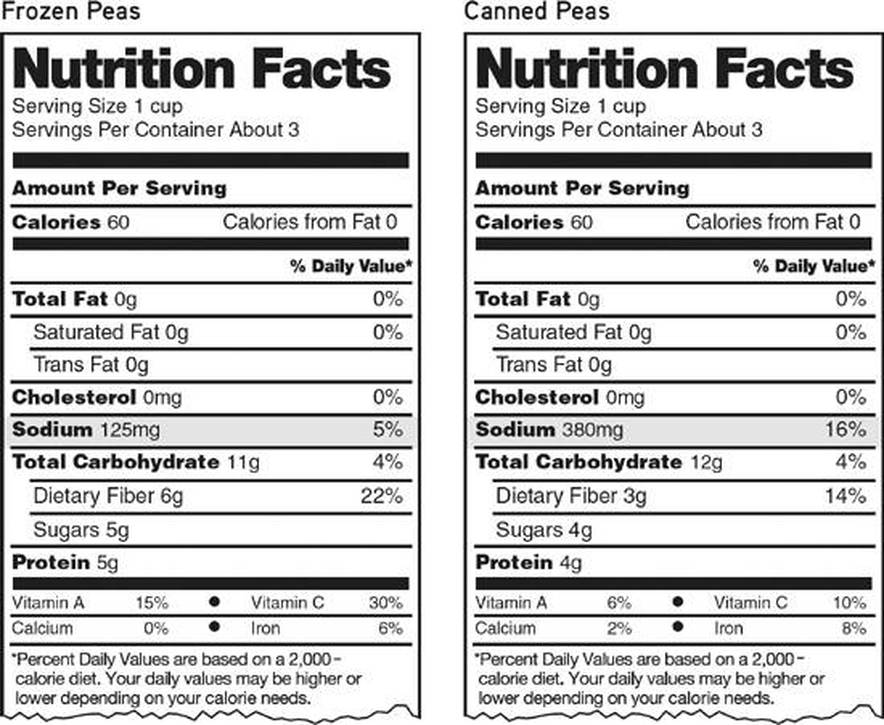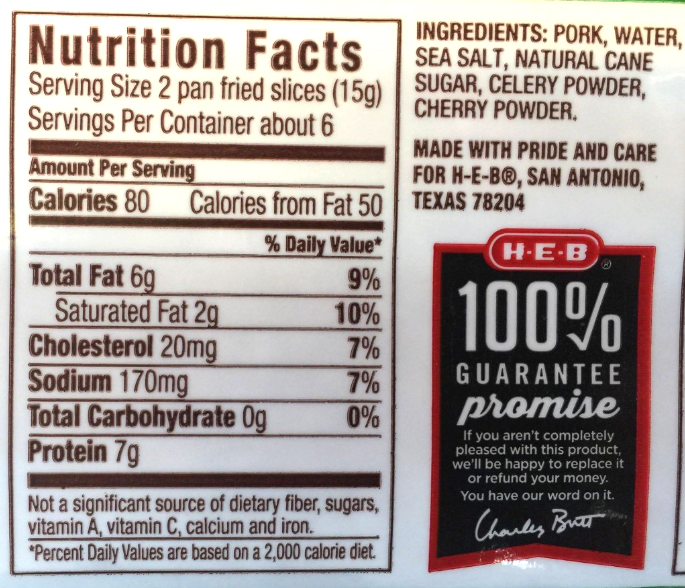43 reading sodium on food labels
› medialibraries › urmcmediaA Guide to Reading Food Labels - University of Rochester Feb 27, 2013 · a single serving of this food come from fat. Due to its high fat content, this food is not a healthy choice. Limit These Nutrients . Americans typically eat too much saturated fat, trans fat, cholesterol, and sodium, which can increase the risk for heart disease, cancer or diabetes. Total fat is important to watch, but saturated fat and trans ... › en › healthy-livingUnderstanding Ingredients on Food Labels | American Heart ... Mar 06, 2017 · Food labels are an important source of information about calories and the nutritional value of the foods you eat, a crucial tool in building a heart-healthy diet. The Nutrition Facts information is always displayed in the same orderly fashion and helps you understand how much of certain nutrients that you need to limit are contained in the ...
How to Read Labels for a Low Sodium Diet - Salt Sanity Sodium nitrate is used to cure meats so you'll likely find it on labels of foods like lunch meat, bacon, and hot dogs. Research indicates sodium nitrate can damage arteries, causing them to harden and narrow, a potentially dangerous situation for patients with heart disease. There are some high sodium ingredients you will recognize.
Reading sodium on food labels
5 tips for decoding food labels - Harvard Health Here are 5 ways to make food labels work for you: Size matters. Serving size is always the first item on the label. All other information is based on that serving size. The servings per container tell you know how many portions are in the whole box, package, or can. Beware: many packages contain more than one serving. 10 Tips for Reading Food Labels: What to Look For You'll find how much sodium is in a product in the middle of the label under "total fats". Your goal should be to stay under 1,-1,500 milligrams of sodium per day. Protein Realistically, any good snack or meal is going to have around 5 grams of protein or more. How do you read a food label for salt / sodium? - Irish Kidney Diet If the salt content is not available on a label you can calculate it from the sodium content using the following: Sodium x 2.5 = salt content or Salt ÷ 2.5 = sodium content If you have kidney disease a good goal for sodium intake is 2300 mg of sodium or 6g salt per day.
Reading sodium on food labels. kidshealth.org › en › teensFood Labels (for Teens) - Nemours KidsHealth A food with 5% or less of a nutrient is low in that nutrient. A food with 10%–19% of a nutrient is a good source of that nutrient. A food with 20% or more of a nutrient is high in that nutrient. The information on food labels is based on an average adult diet of 2,000 calories per day. Sodium: How to Read Food Labels - Intermountain Healthcare 660 milligrams of sodium per serving — your actual percentage of sodium would be 33%, slightly higher than listed. Sodium is listed in milligrams. A food low in sodium should have about 140 milligrams or less per serving. The ingredients list will show you every ingredient in the product. The higher an ingredient appears on the list, Bulletin #4059, Sodium Content of Your Food - Cooperative … The amount of sodium in a serving of food is listed in milligrams (mg) and as a percent of the Daily Value on the nutrition label. ... Removing the saltshaker from the table is one good way to cut sodium intake. When reading labels for sodium content, look for “salt,” “sodium,” “monosodium glutamate,” and sodium added to words like ... Understanding food labels - Canada.ca Find information on food labels and how to understand them. Learn about nutrition facts tables, serving size, list of ingredients, % daily value and nutrition claims. ... Meaning of fat-free, no added sugar, low sodium, other nutrient content claims. Percent daily value. How to calculate % daily value on a nutrition facts table, how to use ...
How to Understand and Use the Nutrition Facts Label | FDA Nutrients to get less of: Saturated Fat, Sodium, and Added Sugars. Saturated fat, sodium, and added sugars are nutrients listed on the label that may be associated with adverse health effects - and... PDF Read the Nutrition Facts Label for Sodium! - NHLBI, NIH Sodium 125mg 5% Total Carbohydrate 9g 3% Dietary Fiber 3g 12% Sugars 4g Protein 2g Vitamin A 35% • Vitamin C 6% Calcium 2% • Iron 2% Read the Nutrition Facts Label for Sodium! Nutrition Facts labels tell you what you need to know about choosing foods that are lower in sodium. Here is a Nutrition Facts label for frozen peas and carrots ... Sodium and Food Labels | Sutter Health It's important to note that all nutritional labels list amounts of nutrients per serving. This item, for example, lists 16 servings in the entire container. The sodium level is 120 mg for one serving. That means if you drink the entire container, you'll get 1,920 mg sodium! That could be a critical error if you're not careful. How to Understand and Use the Nutrition Facts Label | FDA Feb 25, 2022 · Overview. The information in the main or top section (see #1-4) of the sample nutrition label (below) can vary with each food and beverage product; it …
Don't be salty: Reading food labels can help you lower your sodium ... The researchers estimated sodium intake with 24-hour food recalls. They also asked people about how frequently they ate salty snacks/meals and their frequency of using food labels. The study revealed that people who routinely read food labels ate an average of 93 mg less sodium per day and were less likely to eat salty snacks compared to folks ... What Should I Look for When I Read Nutrition Labels? Here's your quick list to determine if the label you're reading passes the PLANTSTRONG sniff test. 1) Sodium: Your recommended total daily intake should be around 1500-2000mg daily so when reading a label, you want the number of calories per serving to be equal to or lesser than the number of milligrams of sodium per serving. (For example ... PDF Controlling Sodium and Reading Labels - Veterans Affairs 2) Check sodium content. Use food labels and packaging to help you select the lowest sodium option. If unable to buy low sodium versions, drain and rinse canned foods under running water to remove excess sodium. • Choose foods with 140 mg sodium or less per serving. • Avoid food with more than 300 mg of sodium per serving. Understanding Food Labels | The Nutrition Source | Harvard … Chile implemented the Law of Food Labeling and Advertising in 2016, comprised of mandatory front-of-package (FOP) warning labels, restrictions on child-directed marketing, and the banning of sales in schools of all foods and beverages containing added sugars, sodium, or saturated fats that exceeded set nutrient or calorie thresholds. [1]
› food › nutritionIs Sodium the Same Thing as Salt? - Eatright.org Aug 08, 2019 · On the label, look for foods that are lower in sodium. Choose foods with less than 120 milligrams of sodium per serving. Look for the words salt-free, sodium-free, very low sodium and low sodium on the label. Double-check sodium content of foods with labels that read unsalted, no salt added, reduced sodium or lower sodium.
› understanding-food-labelsUnderstanding food labels - Canada.ca Find information on food labels and how to understand them. Learn about nutrition facts tables, serving size, list of ingredients, % daily value and nutrition claims.
Food Labels (for Teens) - Nemours KidsHealth A food with 5% or less of a nutrient is low in that nutrient. A food with 10%–19% of a nutrient is a good source of that nutrient. A food with 20% or more of a nutrient is high in that nutrient. The information on food labels is based on an average adult diet of 2,000 calories per day.
Sodium on the Nutrition Facts Label | FDA Most Americans eat too much sodium and diets higher in sodium are associated with an increased risk of developing high blood pressure. The Nutrition Facts label is a handy tool you can use every...
How to Read Salt Labels | Cooking Light When food companies make sodium claims, they have to follow labeling rules. For the consumer, the tricky part is that there are four claims. Two apply when a company is comparing their food to a loosely defined fully salted version. One refers to a specific sodium level, another to whether salt has been added.
Sodium & Your Heart Health: How To Read Nutrition Facts On Food Labels Food can be considered low-sodium if the total sodium content is 140mg or less and is based on serving size. Overindulging on the portions with a low-sodium food can potentially be just as detrimental as eating a food that's high in salt. Additionally, people shopping for low-sodium foods should opt for packaging that features a 5% DV or lower.
Reading Food Labels | ADA - American Diabetes Association It’s time to decode those food claims. Trying to figure out nutritional information on labels and packaging isn’t easy. The good news is that we can help. Untangle packaging claims. If you get tripped up on food content claims, you’re not alone. Fat free vs. low fat vs. reduced fat. Low ...
Reading Labels - World Action on Salt & Health Some food labels may only state the sodium content. To convert sodium to salt, you need to multiply the amount by 2.5. For example, 1g of sodium per 100g = 2.5 grams of salt per 100g. You then need to know the weight of the serving portion in grams e.g. 30g. Then divide the concentration of salt per 100g by 100 and multiply by the serving size.





Post a Comment for "43 reading sodium on food labels"